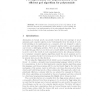CADE
2006
Springer
15 years 22 days ago
2006
Springer
We define an interpretation of the Isabelle/HOL logic in HOL Light and its metalanguage, OCaml. Some aspects of the Isabelle logic are not representable directly in the HOL Light o...
CADE
2006
Springer
15 years 22 days ago
2006
Springer
We describe here a formal proof in the Coq system of the structure theorem for subresultants, which allows to prove formally the correctness of our implementation of the subresulta...
CADE
2006
Springer
15 years 22 days ago
2006
Springer
Context Unification is the problem to decide for a given set of second-order equations E where all second-order variables are unary, whether there exists a unifier, such that for e...
CADE
2006
Springer
15 years 22 days ago
2006
Springer
Linear arithmetic decision procedures form an important part of theorem provers for program verification. In most verification benchmarks, the linear arithmetic constraints are dom...
CADE
2006
Springer
15 years 22 days ago
2006
Springer
Abstract. Based on inductive definitions, we develop an automated tool for defining partial recursive functions in Higher-Order Logic and providing appropriate reasoning tools for ...
CADE
2006
Springer
15 years 22 days ago
2006
Springer
Abstract. We introduce a semi-automated proof system for basic category-theoretic reasoning. It is based on a first-order sequent calculus that captures the basic properties of cat...
CADE
2006
Springer
15 years 22 days ago
2006
Springer
Abstract. Semantic labelling is a transformational technique for proving termination of Term Rewriting Systems (TRSs). Only its variant with finite sets of labels was used so far i...
CADE
2006
Springer
15 years 22 days ago
2006
Springer
We present a resolution-based decision procedure for the description logic SHOIQ--the logic underlying the Semantic Web ontology language OWL-DL. Our procedure is goal-oriented, an...
CADE
2006
Springer
15 years 22 days ago
2006
Springer
This paper presents new classes of tree automata combining automata with equality test and automata modulo equational theories. We believe that these classes have a good potential ...
CADE
2006
Springer
15 years 22 days ago
2006
Springer
Abstract. Verification by network invariants is a heuristic to solve uniform verification of parameterized systems. Given a system P, a network invariant for P is that abstracts th...



